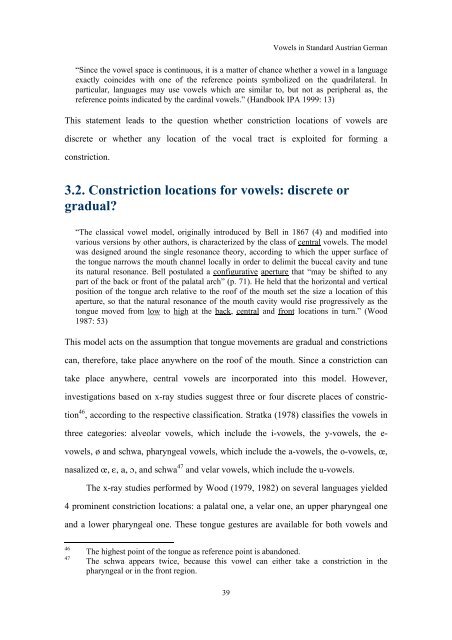VOWELS IN STANDARD AUSTRIAN GERMAN - Acoustics ...
VOWELS IN STANDARD AUSTRIAN GERMAN - Acoustics ...
VOWELS IN STANDARD AUSTRIAN GERMAN - Acoustics ...
Create successful ePaper yourself
Turn your PDF publications into a flip-book with our unique Google optimized e-Paper software.
39<br />
Vowels in Standard Austrian German<br />
“Since the vowel space is continuous, it is a matter of chance whether a vowel in a language<br />
exactly coincides with one of the reference points symbolized on the quadrilateral. In<br />
particular, languages may use vowels which are similar to, but not as peripheral as, the<br />
reference points indicated by the cardinal vowels.” (Handbook IPA 1999: 13)<br />
This statement leads to the question whether constriction locations of vowels are<br />
discrete or whether any location of the vocal tract is exploited for forming a<br />
constriction.<br />
3.2. Constriction locations for vowels: discrete or<br />
gradual?<br />
“The classical vowel model, originally introduced by Bell in 1867 (4) and modified into<br />
various versions by other authors, is characterized by the class of central vowels. The model<br />
was designed around the single resonance theory, according to which the upper surface of<br />
the tongue narrows the mouth channel locally in order to delimit the buccal cavity and tune<br />
its natural resonance. Bell postulated a configurative aperture that “may be shifted to any<br />
part of the back or front of the palatal arch” (p. 71). He held that the horizontal and vertical<br />
position of the tongue arch relative to the roof of the mouth set the size a location of this<br />
aperture, so that the natural resonance of the mouth cavity would rise progressively as the<br />
tongue moved from low to high at the back, central and front locations in turn.” (Wood<br />
1987: 53)<br />
This model acts on the assumption that tongue movements are gradual and constrictions<br />
can, therefore, take place anywhere on the roof of the mouth. Since a constriction can<br />
take place anywhere, central vowels are incorporated into this model. However,<br />
investigations based on x-ray studies suggest three or four discrete places of constric-<br />
tion 46 , according to the respective classification. Stratka (1978) classifies the vowels in<br />
three categories: alveolar vowels, which include the i-vowels, the y-vowels, the e-<br />
vowels, ë and schwa, pharyngeal vowels, which include the a-vowels, the o-vowels, ê,<br />
nasalized ê, E, a, O, and schwa 47 and velar vowels, which include the u-vowels.<br />
The x-ray studies performed by Wood (1979, 1982) on several languages yielded<br />
4 prominent constriction locations: a palatal one, a velar one, an upper pharyngeal one<br />
and a lower pharyngeal one. These tongue gestures are available for both vowels and<br />
46<br />
The highest point of the tongue as reference point is abandoned.<br />
47<br />
The schwa appears twice, because this vowel can either take a constriction in the<br />
pharyngeal or in the front region.












